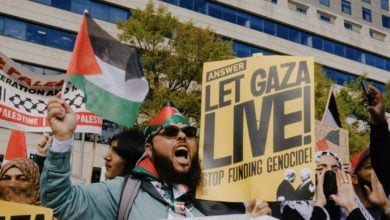Sept. 15, 2007 will mark the 25th anniversary of the Sabra and Shatila massacre. From Sept. 15-17, 1982, Lebanese fascist paramilitaries, under the watchful eyes of the Israeli military occupiers, slaughtered more than 2,000 Palestinian residents of two refugee camps in Beirut. The overwhelming majority of those murdered were women, children and elderly men.
Thousands of people will march on Sept. 15 in Washington, D.C. to demand the immediate end of the war in Iraq. On that day we, along with people throughout the world, will also remember and salute the victims of the Sabra and Shatila Massacre. The Arab people, throughout the Middle East must have justice and self-determination.
In June 1982, the Israeli military (IDF), with full support of the Reagan regime, launched a massive invasion of Lebanon. The objectives of the invasion were to destroy the Palestine Liberation Organization, then based mainly in Lebanon, and install a puppet government in Beirut. The U.S. continually re-supplied the IDF throughout the war.
The invasion of Lebanon culminated in the Sept. 15-17 rampage through two disarmed Palestinian refugee camps by 1,500 fighters of the racist and fascist Lebanese Forces, one of the right-wing Lebanese organizations allied with Israel.
For the entire summer of that year, the IDF mercilessly bombed the Lebanese capital, killing more than 20,000 people, the vast majority of them civilians. In September 1982, a ceasefire agreement was forced upon the Lebanese and Palestinians resisting the assault. Palestinian refugees made up more than 10 percent of Lebanon’s population of 3 million at the time.
Under the agreement, PLO military forces would be evacuated to Tunisia. In return, the safety and security of the Palestinian refugee camps would be guaranteed. Among the signers of this agreement were the governments of the United States and Israel.
The security guarantee was critical, because it was well known to all parties that the Lebanese Forces and other racist and fascist militias would butcher the residents of the camps if they were left unprotected.
By Sept. 15, with the PLO fighters gone, the IDF had completely surrounded the Sabra and Shatila refugee camps in west Beirut. The remaining inhabitants of the camps were nearly all women, children or elderly men.
However, Ariel Sharon, then Israel’s defense minister, along with the Israeli commanders on the ground declared that they believed there were still PLO fighters hiding in the camps.
Using this pretext, Sharon ordered that the Lebanese Forces (LF), commanded by Elie Hobeika, be allowed enter the Palestinian camps to “clean out terrorist nests.”
A weekend of unimaginable horror ensued. The LF first went door-to-door, forcing the terrified inhabitants out into the streets and dividing them into groups.
Shortly after they entered the camps, an LF commander radioed Hobeika, who was in the presence of Israeli officers. The LF commander asked Hobeika what he should do with the women and children, to which Hobeika responded angrily, shouting over his radio: “You know exactly what to do!” (BBC documentary, “The Accused,” 2001)
The slaughter then began in earnest. For the next 36 hours, the LF raped, tortured and slaughtered, wiping out nearly the entire population of more than 2,000 Palestinians and Lebanese living in Sabra and Shatila.
Israeli officers and cabinet ministers, including Ariel Sharon—who as defense minister bore overall responsibility for the occupation of Lebanon—were repeatedly informed of what was going on. When the Israelis finally instructed Hobeika to pull the LF forces out on Sept. 17, the LF asked for, and received, a one-day extension to “finish their work.”
Once the hideous images of the Sabra and Shatila massacre were flashed around the world, the anger and revulsion were so great that even Israel had to set up an official commission of inquiry the following year. The Kahan Commission found Sharon “indirectly responsible” for the massacre. He was forced to resign as defense minister, although not from the Israeli cabinet. Two decades later, Sharon ascended to Israel’s highest office, prime minister.
Sabra and Shatila was neither Sharon’s first nor last massacre. The fact that this war criminal could commit such widely known acts and yet go on to become prime minister is the clearest sign of the Israeli state’s profoundly racist character.
Twenty-five years after the Sabra and Shatila Massacre, Sharon’s successors—with massive support from Washington—continue their occupation of Palestine and brutal repression of the Palestinian people.
The aim of the 1982 massacre was to break the spirit of the Palestinian people and crush their resistance by means of an extraordinarily horrific terrorist act. It failed to achieve that objective.
Today, the struggle of the Palestinian people for self-determination, including the fundamental right of those living in exile to return to their homeland, continues. What is taking place now in Palestine, just 600 miles from Iraq, cannot be separated from the larger struggle against U.S. occupation and domination in the region.
The Arab American and Muslim communities have been in the forefront of building the U.S. anti-war movement, protesting the criminal U.S. war in Iraq and demanding justice for the Palestinian people.
On Sept. 15, 2007 the ANSWER Coalition (Act Now to Stop War and End Racism) and others in the anti-war movement will join with justice-minded people around the world in paying tribute to the victims of a terrible crime committed a quarter-century ago, and stand as always in solidarity with the struggling people of Palestine.
55 4 minutes read






